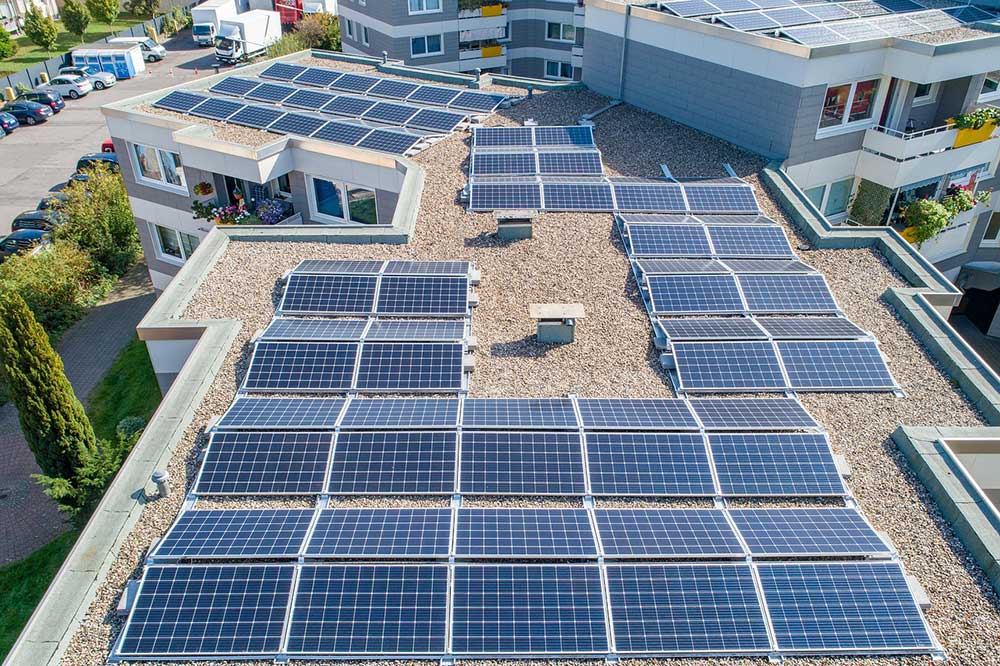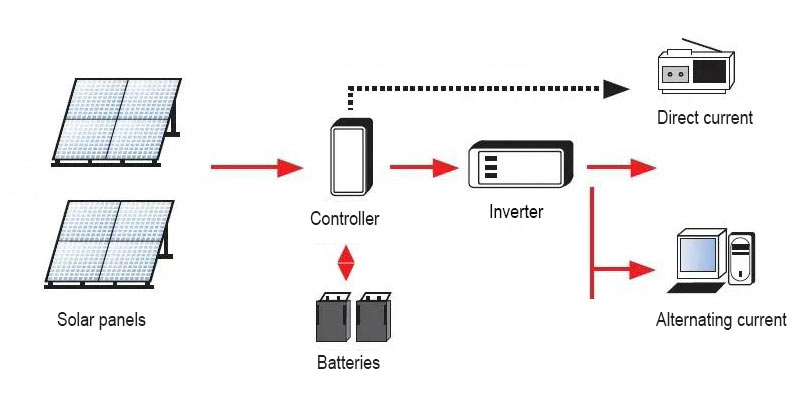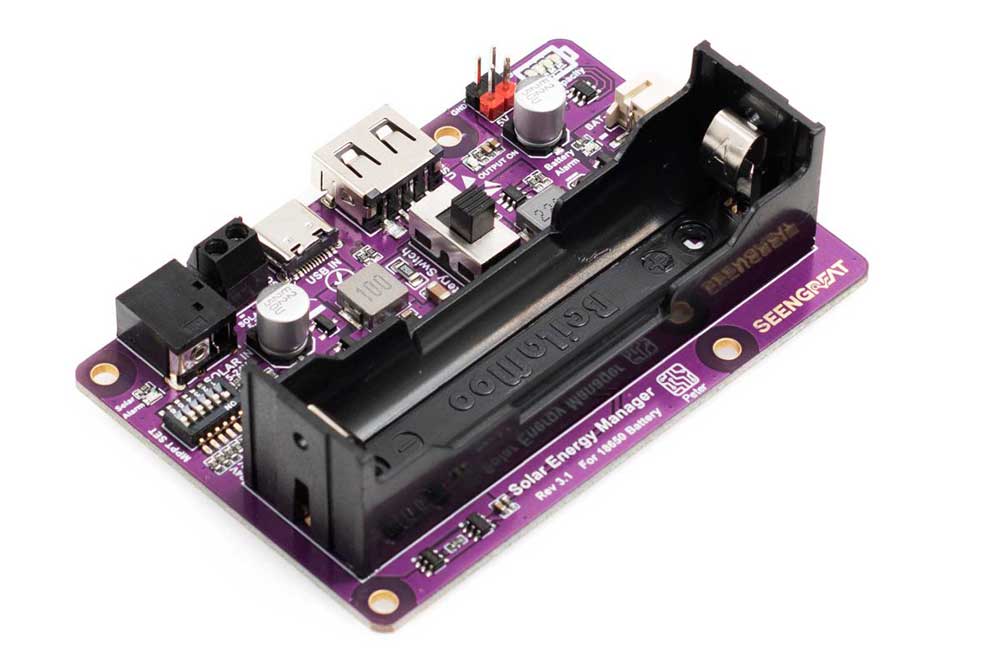
Solar energy is one of the fastest-growing renewable energy sources in the world, it has become a major part of sustainable energy systems. The uses of solar power extend to various products, including solar water heaters, garden lighting, solar street lamps, and outdoor meteorological monitoring, marking a growing trend toward harnessing the potential of solar resources.
In this article, we will walk you through solar energy system's working principle, charging methods, and maintenance, so you get a better grasp on the issue of solar products.
Solar Energy System
Solar systems primarily fall into two categories: on-grid and off-grid. As their names suggest, the major difference between the on-grid and off-grid solar systems is their power access. On-grid systems integrate with the electric grid and provide supplementary power alongside the utility power grid. On the other hand, off-grid systems operate independently, relying on battery storage.
Speaking of advantages, an on-grid solar system delivers reliable power regardless of weather or time, eliminating the need for additional batteries or storage.
In terms of power outages, off-grid seems more beneficial since this system operates independently, they remain unaffected by disruptions in the main power supply. Besides that, off-grid is more budget-friendly in the long run.
Despite their distinctions, both types offer comparable advantages. Choosing the right solar system for your household or business hinges on your requirements and situation. Understanding the differences between on-grid, off-grid, or hybrid systems can guide you toward the best fit.
Solar energy systems work by solar cells (like photovoltaic solar panels) absorbing sunlight and converting it into electricity, and then inverters turn the DC power into usable AC current. A solar system is more than just solar cells, it usually consists of the following components.
- Solar cells. Solar cells are used to absorb sunlight and convert it into electricity on sunny days. Even on cloudy days, your panels can still generate electricity as the sunlight passes through the clouds. As the most visible element of solar systems, they are usually installed on the roof or placed together at scale to form solar arrays (solar farms).
- Controllers. Including various meters, sensors and monitoring equipment, these controllers are used to process signals, detect operating conditions, manage solar cells and batteries, control switches and more. For instance, when solar panels charge batteries via a charge controller, it regulates voltage and the current from solar cells to prevent overcharging or over-discharging. Controllers are very visible in the IoT-based renewable energy grids.
- Inverter. An inverter is meant to convert the direct current (DC) power generated by solar power generation into alternating current (AC) power. DC power must be converted to AC power before it can be fed into the grid for local use or transmitted to households.
- Solar Batteries. Batteries are used to store energy generated by solar cells during the day so that they can be used throughout the night when the system is no longer generating power. They play an important role especially in off-grid, hybrid energy systems, and backup power systems.

Solar Energy Storage
The electricity generated by solar panels is either used directly in the property where it's installed or fed back into the grid.
The solar cells themselves can not store power, thus extra batteries are needed for this purpose. In some cases when solar cells are generating more electricity than home uses, excess energy can be sent to the grid or stored in batteries, which is very helpful in the situation of night, cloudy days, or power outages.
This generated electricity can be stored primarily in two ways:
- Solar batteries: The electricity generated by solar panels is connected to a battery pack for storage, including lithium-ion batteries, lead-acid batteries. The direct current (DC) electricity produced by solar panels can be stored in batteries without being converted to alternating current (AC).
- Renewable energy grids: The electricity generated by solar panels can be connected directly to the grid instead of being stored in local batteries. Renewable energy generation systems (such as solar power systems, wind turbines, biogas power systems, etc.) are typically established closer to end-users of electricity to meet all or part of their electricity needs. These renewable energy generation systems can be designed as standalone systems or interconnected with the traditional electric grid.
Solar Energy System Maintenance
Solar panels on its own don't have many moving parts, so they don't require much maintenance, and residential solar panels require little maintenance beyond regular cleaning. Nonetheless, it's important to keep an eye on the condition and performance of your home solar panel system.
Over time, dust and dirt will build up, solar cells may be covered with leaves, bird droppings or other objects, all of these can reduce the energy output of solar system. The longer the time, the more the accumulation, and the harder it becomes to clean.
Rain or wind can wash away these debris, especially if they are on a tilt, giving your solar panels a natural cleanup for free. However, it is still necessary to conduct a visual inspection after extreme weather events, aiming to ensure the stable efficiency and condition of solar powerhouse.
In cases like dry season or when there has been no rain for a long time, a manual cleanup is necessary. It is usually recommended twice a year, the best time is the early morning or at sunset so that the panels do not get too hot from the sun.
Cleaning solar panels is as simple as grabbing a hose or bucket and spraying water on the panels! For something difficult to clean, like bird droppings, oily pollutants and other sticky pollutants, using soft brush, washcloths and water gun to wipe them off. Keep an eye on the pressure of the water gun, too much water pressure may cause damage to the solar panels. Also avoid using chemical cleaning agents, or hard and sharp objects to directly touch the solar panels.
For large solar systems or those in remote areas, that is where the Internet of Things (IoT) technology comes into play.
Integrating sensors and smart devices into solar energy systems allows for the collection of various data and precise controls, such as sunlight intensity, temperature, panel tilt angle, electricity output, and more. These data is transmitted via the internet to a central control system or cloud platform, where real-time data are processed and analyzed, leading to better overall performance. The monitoring system will also alert you in case of panel damage or malfunction, enabling prompt repairs or replacements.
With the help of IoT, the entire solar system, including panels, inverters and other components, can be monitored using IoT devices so that any performance issues can be identified and resolved in a timely manner. Moreover, IoT helps to schedule maintenance based on the condition and performance of the solar panels, enabling predictive maintenance.
Solar Charge Controller
A solar charge controller, also known as a solar voltage regulator, is a battery charger connected between the solar panels and battery, aiming to stabilize the unstable voltage from the solar panels, making it suitable for charging batteries. Its job is to regulate the battery charging process and provide overload protection, low voltage disconnects, and reverse current blockage. Ultimately, the charge controller aims to prolong battery life and maximize the efficiency of the off-grid system.
The voltage of power generated by solar panels is unstable. For example, the 12v solar panel might give off up to 20 volts. It is normally influenced by various factors such as sunlight intensity, shading, dirt and dust buildup, environmental conditions, and use patterns.
There are two main types of solar charge controllers on the market - MPPT controllers and PWM controllers. The main difference between the two is that the PWM charge controller regulates only the current, which is simpler and more economical, it is a cost-effective option for smaller systems with fewer panels. The MPPT charge controller regulates both the voltage and current, which is more efficient, safer, and performs better, especially in large solar systems.
The selection between MPPT and PWM controllers comes down to your needs, budgetary constraints, and your system size.
- MPPT stands for maximum power point tracking. With a MPPT charge controller, solar panels can operate at their maximum power point and therefore can generate much more power. MPPT controllers have higher efficiency, leading to increased energy output and faster charging times. MPPT controllers can generate up to 30% more power compared to PWM charge controllers, and they tend to perform better on cloudy days, hazy days, or cold weather.
- PWM stands for pulse width modulation. Although less efficient, PWM controllers are budget-friendly and still provide sufficient charging capabilities for small-scale applications and low-power systems under 170W. The PWM solar charge controller is an ideal option for small 12V systems using one or two solar panels for simple applications such as solar lighting, camping, and USB phone chargers.

Solar Lithium Batteries
Combining lithium batteries and solar energy is one of the best solutions for solar energy applications. They are commonly used in solar energy systems to store surplus solar power as rechargeable energy storage solutions, reducing dependence on the grid.
Lithium-ion batteries are the most common batteries used in consumer electronics. They are widely used in our everyday life from cell phones, laptops, and portable power supplies to electric vehicles. With the advantages of a long lifespan, compact size, and adaptability to inconsistent charging and discharging, they are an ideal choice for most household uses and commercial solar power systems.
The advantages of lithium batteries included:
- A long lifespan. Solar lithium batteries can be charged sustainably for over 2000 cycles, lasting approximately 10 years or longer.
- Higher energy density. Lithium-ion batteries have one of the highest energy densities of any commercial battery technology, taking up less space. lithium batteries can store 3 to 5 times more energy than lead-acid batteries at the same level of weight.
- Low maintenance. Lithium-ion batteries are relatively low maintenance and don't require scheduled cycling to maintain their battery life.
Related Questions
Can solar energy system work on cloudy days?
Ideally, solar panel systems provide peak efficiency on cool, sunny days. On the other hand, they still can function across various climates although susceptible to temporary weather interruptions. Cloudy days diminish electricity generation, while cold weather doesn't impact productivity. In fact, snowfall can benefit your solar system by cleansing the panels as it melts. Additionally, sunlight reflected off the snow boosts the light hitting your panels, leading to increased electricity production as a result.
How does MPPT solar charge controller work?
MPPT solar charge controllers work on a relatively simple principle, they regulate the voltage and current coming from the solar cells going to the battery, aiming for overload protection, low voltage disconnects, and reverse currents blockage. The panel voltage and current are constantly changing as sunlight intensity on a solar panel varies throughout the day. To produce maximum power, the MPPT scans the panel voltages to find the best combination of voltage and current to produce maximum power. The MPPT constantly tracks and adjusts the photovoltaic voltages to produce maximum power regardless of time of day or weather conditions.
What is Solar Cell
A solar cell is an electronic device that converts the energy of light directly into electricity through the photovoltaic effect, solar panels are a common form of solar cells. The most notable parameter for solar cells is the photovoltaic conversion efficiency, which refers to the portion of energy in the form of sunlight that can be converted via photovoltaics into electricity by the solar cell. In this regard, the number normally sits between 10% and 20%.
Can solar panels directly charge lithium batteries?
No. The produced voltage by solar cells is usually unstable due to the changing weather conditions, the stronger the light, the higher the voltage, causing the output voltage unstable for powering devices directly. To address this, a voltage regulator or charge controller is needed when charging lithium batteries using solar panels. A charge controller is to regulate the voltage from the solar panels, avoiding overcharging on sunny days.
A voltage regulator or charge controller is used to stabilize the erratic output voltage from the solar panels, making it suitable for charging batteries.
Indeed, there are some all-in-one solar power systems in which all required components are already included, ensuring no compatibility hassle. Simply connect the solar panels and start using it hassle-free.
What is the lifespan of solar panels?
The lifespan of solar cells is largely affected by the material and environment, it is usually 15 to 25 years. Solar panels are easy to maintain, solar cells like any other electrical devices are subject to aging due to use and the environment. Normally, the power of solar cells will decay 30% in 20 years, and 70% in 25 years.

 Comments
Comments